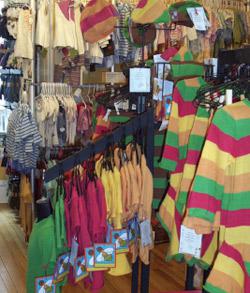Selling Clothing and Predicting the Future

The store was packed with babies, toddlers, mommies, and daddies. Organic juice boxes and cookies helped keep the mini-mob under control, and conversations about potty training outnumbered other topics.
Linden Hills Natural Home was hosting a photo shoot/model search for a line of organic baby clothes, and for weeks the excitement had been building. So many people had signed up for appointments that we added another hour to the photo session. For five hours, the photographer and her patient assistant (a former nanny) wrangled wriggly babies, adorable two-year-olds, scene-stealing big sisters, and slightly frazzled parents, as our staff watched in wonder.
At the end of the day, we had sold five clothing items. Although the event wasn’t an immediate success in terms of generating sales, a good time was had by all—and perhaps the “feel good” aspect will bring us some future customers. Does it mean your co-op should venture into retailing clothing?
According to The Organic Exchange “Organic Cotton Market Report” for spring 2006, demand for organic cotton is expected to grow at an average rate of 110 percent between 2006 and 2008, to more than $2 billion worldwide. While this may prove true, Sam’s Club and Wal-Mart are already among the top five brands using the greatest amount of organic cotton. Patagonia, Levi-Strauss, and Nike are also major retailers of organic cotton attire. Consumer studies indicate that shoppers in the U.S. are willing to spend up to 20 percent more on “eco-friendly” products like organic clothing. Whether this will translate into a great line extension for food cooperatives remains to be seen.
Linden Hills Natural Home has included a limited selection of clothing in our store since we opened on Earth Day 2005. What we’ve learned about retailing clothes parallels what we’ve learned about other aspects of specialty retailing (as opposed to grocery sales). Unlike predicting that pumpkins will sell well in October and citrus in January, you never know what people are going to want, when they’re going to want it, and how much they’ll actually buy from you. To some extent, your success depends on your buyers’ ability to predict the future.
Store manager Steve Kobs says, “If you have a hot seller (a fast-moving style, color, or size), by the time you can reorder and restock it, the sales window has slammed shut. Chances are you’ll end up with more misses than hits, and you’ll always have to reduce the price on what you have left. If you start a line at a 50 percent margin, about the best you can expect on the entire order is 40 percent.”
“The good news is that clothing sales are highly seasonal,” he continues, “with the exception of socks and underwear, which do sell throughout the seasons. At least in Minnesota, where we have seasons.”
Linden Hills Natural Home has 800 square feet of selling space. While clothing (primarily organic and Fair Trade cotton clothing for infants and toddlers) takes up about 10 percent of our display space, it represents 6 percent to 8 percent of annual sales. Our buyers, Jen Rubey and Shannon Doolan, have three children under six between them, and their personal experience and taste has played a sizeable role in product selection, along with our product guidelines: organic, local, fair trade and recycled/recyclable whenever possible. National baby and toddler lines such as Under the Nile, Speesees, and happygreenbee are part of the mix, along with Maggie’s Organic Cotton camisoles and socks for grownups. Local and fair trade lines tend to sell well, too; one local woman makes baby and toddler rompers, dresses, and hats from organic cotton, with recycled cotton fabric as accents.
Should your store branch out into organic clothing sales? It depends on your market area, available space, and competition. Linden Hills Natural Home is just blocks away from an upscale baby boutique and a store that specializes in fashionable organic and Fair Trade clothing, primarily for adults. And the Whole Foods Market less than a mile away has recently increased its selection of organic cotton clothing. So the competition is fierce—but our unique product lines, incorporating fair trade, organic, and local—set us apart sufficiently. While we plan to continue to offer clothing for toddlers and babies as well as hats, gloves, scarves, socks, and underwear for adults, we don’t expect our sales to grow by 110 percent.
Here are some fashion tips from Steve Kobs, store manager at Linden Hills Natural Home:
- Visibility really makes a difference in clothing sales. Hanging a bunch of shirts or onesies on a rack just doesn’t work.
- If you’re selling adult (and sometimes even toddler) clothes, you can’t really do it without a dressing room. A full-length mirror in a well-lit place helps some.
- Staff recommendations are extremely helpful in promoting sales. If your staff know how comfy and durable those socks are, be sure they tell customers.
We don’t have hard data on this, but we’re pretty sure the majority of our baby clothes are bought as gifts. Having gift bags/boxes and cards nearby is great for add-on sales.
***
Jeanne Lakso is marketing and member services manager at Linden Hills Co-op & Natural Home in Minneapolis, Minnesota ([email protected]).







